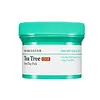What's inside
What's inside
 Key Ingredients
Key Ingredients

 Benefits
Benefits

 Concerns
Concerns

 Ingredients Side-by-side
Ingredients Side-by-side

Water
Skin ConditioningGlycerin
HumectantCI 77004
Cosmetic ColorantHydrogenated Polydecene
EmollientCI 77891
Cosmetic ColorantPalmitic Acid
EmollientCetearyl Alcohol
EmollientCaprylic/Capric Triglyceride
MaskingStearic Acid
CleansingCetearyl Olivate
Sodium Acrylate/Sodium Acryloyldimethyl Taurate Copolymer
Emulsion StabilisingButylene Glycol
Humectant1,2-Hexanediol
Skin ConditioningDimethicone
EmollientGlyceryl Stearate
EmollientPropanediol
SolventAmmonium Acryloyldimethyltaurate/Vp Copolymer
Sorbitan Olivate
EmulsifyingIsohexadecane
EmollientHydroxyacetophenone
AntioxidantCI 77492
Cosmetic ColorantCI 77288
Cosmetic ColorantCetyl Ethylhexanoate
EmollientPolysorbate 80
EmulsifyingHydroxyethylcellulose
Emulsion StabilisingCI 77499
Cosmetic ColorantAluminum Hydroxide
EmollientDisodium EDTA
Ethylhexylglycerin
Skin ConditioningParfum
MaskingCentella Asiatica Extract
CleansingSorbitan Oleate
EmulsifyingMyristic Acid
CleansingTetrasodium Pyrophosphate
BufferingCymbopogon Schoenanthus Extract
Skin ConditioningCamellia Sinensis Leaf Extract
AntimicrobialSodium Hyaluronate
HumectantHyaluronic Acid
HumectantHydrolyzed Hyaluronic Acid
HumectantCastanea Crenata Shell Extract
Skin ConditioningLavandula Angustifolia Flower Extract
CleansingVaccinium Macrocarpon Fruit Extract
AstringentDisodium Phosphate
BufferingPolysorbate 60
EmulsifyingCharcoal Powder
AbrasivePolyglyceryl-10 Stearate
Skin ConditioningSodium Phosphate
BufferingPolyglyceryl-10 Myristate
Skin ConditioningPropolis Extract
Skin ConditioningAsiaticoside
AntioxidantCitric Acid
BufferingSodium Dehydroacetate
PreservativeAsiatic Acid
Skin ConditioningMadecassoside
AntioxidantMadecassic Acid
Skin ConditioningWater, Glycerin, CI 77004, Hydrogenated Polydecene, CI 77891, Palmitic Acid, Cetearyl Alcohol, Caprylic/Capric Triglyceride, Stearic Acid, Cetearyl Olivate, Sodium Acrylate/Sodium Acryloyldimethyl Taurate Copolymer, Butylene Glycol, 1,2-Hexanediol, Dimethicone, Glyceryl Stearate, Propanediol, Ammonium Acryloyldimethyltaurate/Vp Copolymer, Sorbitan Olivate, Isohexadecane, Hydroxyacetophenone, CI 77492, CI 77288, Cetyl Ethylhexanoate, Polysorbate 80, Hydroxyethylcellulose, CI 77499, Aluminum Hydroxide, Disodium EDTA, Ethylhexylglycerin, Parfum, Centella Asiatica Extract, Sorbitan Oleate, Myristic Acid, Tetrasodium Pyrophosphate, Cymbopogon Schoenanthus Extract, Camellia Sinensis Leaf Extract, Sodium Hyaluronate, Hyaluronic Acid, Hydrolyzed Hyaluronic Acid, Castanea Crenata Shell Extract, Lavandula Angustifolia Flower Extract, Vaccinium Macrocarpon Fruit Extract, Disodium Phosphate, Polysorbate 60, Charcoal Powder, Polyglyceryl-10 Stearate, Sodium Phosphate, Polyglyceryl-10 Myristate, Propolis Extract, Asiaticoside, Citric Acid, Sodium Dehydroacetate, Asiatic Acid, Madecassoside, Madecassic Acid
Water
Skin ConditioningKaolin
AbrasiveDipropylene Glycol
HumectantCentella Asiatica Extract
CleansingMelaleuca Alternifolia Leaf Extract
PerfumingBentonite
AbsorbentBetaine
HumectantAlcohol Denat.
AntimicrobialSilica
Abrasive1,2-Hexanediol
Skin ConditioningPolyglyceryl-4 Caprate
EmulsifyingCoco-Glucoside
CleansingCellulose
AbsorbentMelaleuca Alternifolia Flower/Leaf/Stem Extract
Skin ConditioningSodium Hyaluronate
HumectantCalamine
AbsorbentXanthan Gum
EmulsifyingChlorella Vulgaris Powder
Skin ConditioningGluconolactone
Skin ConditioningTriethoxycaprylylsilane
Illite
AbrasiveMontmorillonite
AbsorbentManicouagan Clay
AbsorbentCanadian Colloidal Clay
Skin ConditioningHydrolyzed Sodium Hyaluronate
Skin ConditioningHydrolyzed Hyaluronic Acid
HumectantHectorite
AbsorbentHydroxyacetophenone
AntioxidantEthylhexylglycerin
Skin ConditioningWater, Kaolin, Dipropylene Glycol, Centella Asiatica Extract, Melaleuca Alternifolia Leaf Extract, Bentonite, Betaine, Alcohol Denat., Silica, 1,2-Hexanediol, Polyglyceryl-4 Caprate, Coco-Glucoside, Cellulose, Melaleuca Alternifolia Flower/Leaf/Stem Extract, Sodium Hyaluronate, Calamine, Xanthan Gum, Chlorella Vulgaris Powder, Gluconolactone, Triethoxycaprylylsilane, Illite, Montmorillonite, Manicouagan Clay, Canadian Colloidal Clay, Hydrolyzed Sodium Hyaluronate, Hydrolyzed Hyaluronic Acid, Hectorite, Hydroxyacetophenone, Ethylhexylglycerin
Ingredients Explained
These ingredients are found in both products.
Ingredients higher up in an ingredient list are typically present in a larger amount.
1,2-Hexanediol is a synthetic liquid and another multi-functional powerhouse.
It is a:
- Humectant, drawing moisture into the skin
- Emollient, helping to soften skin
- Solvent, dispersing and stabilizing formulas
- Preservative booster, enhancing the antimicrobial activity of other preservatives
Centella Asiatica Extract (Centella) is derived from an herb native to Southeast Asia. It is famous for its anti-inflammatory and soothing properties.
Centella is rich in antioxidants and amino acids, such as Madecassic Acid and Asiaticoside.
Studies show the compounds in centella help with:
The combination of all these properties makes centella effective at soothing, hydrating, and protecting the skin.
Other great components of centella include Vitamin A, vitamin C, several B vitamins, and Asiatic Acid.
Fun fact: Centella has been used as a medicine and in food for many centuries. As a medicine, it is used to treat burns, scratches, and wounds.
Learn more about Centella Asiatica ExtractEthylhexylglycerin (we can't pronounce this either) is commonly used as a preservative and skin softener. It is derived from glyceryl.
You might see Ethylhexylglycerin often paired with other preservatives such as phenoxyethanol. Ethylhexylglycerin has been found to increase the effectiveness of these other preservatives.
Hydrolyzed Hyaluronic Acid is a form of hyaluronic acid. It is created by the hydrolysis of hyaluronic acid with a high molecular weight. Once created, Hydrolyzed Hyaluronic Acid has a low molecular weight.
Low molecular weight HA has been shown to hydrate and increase elasticity of the skin. Increasing elasticity is also associated with reduction of wrinkle depth.
One study found topical low molecular weight hyaluronic acid may be considered for the treatment of rosacea in the adult population. However, we always recommend speaking with a professional about your skin concerns.
Hyaluronic acids are a humectant. This means they draw moisture from the air. Hyaluronic acids help moisturize, soothe, and protect the skin.
Read more about other common forms of hyaluronic acid:
Learn more about Hydrolyzed Hyaluronic AcidHydroxyacetophenone is antioxidant with skin conditioning and soothing properties. It also boosts the efficiency of preservatives.
This ingredient is not irritating or sensitizing.
Sodium Hyaluronate is hyaluronic acid's salt form. It is commonly derived from the sodium salt of hyaluronic acid.
Like hyaluronic acid, it is great at holding water and acts as a humectant. This makes it a great skin hydrating ingredient.
Sodium Hyaluronate is naturally occurring in our bodies and is mostly found in eye fluid and joints.
These are some other common types of Hyaluronic Acid:
Learn more about Sodium HyaluronateWater. It's the most common cosmetic ingredient of all. You'll usually see it at the top of ingredient lists, meaning that it makes up the largest part of the product.
So why is it so popular? Water most often acts as a solvent - this means that it helps dissolve other ingredients into the formulation.
You'll also recognize water as that liquid we all need to stay alive. If you see this, drink a glass of water. Stay hydrated!
Learn more about Water